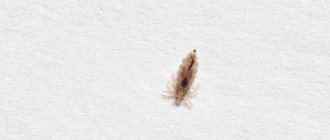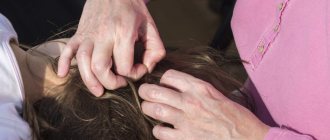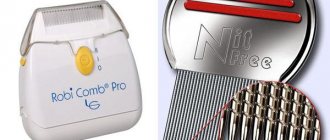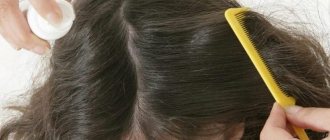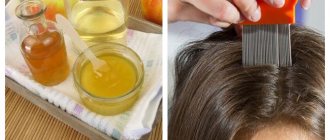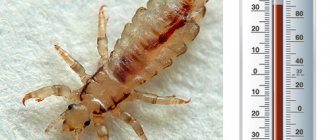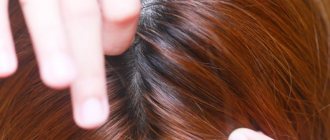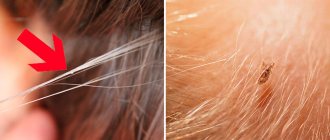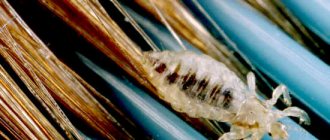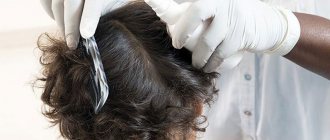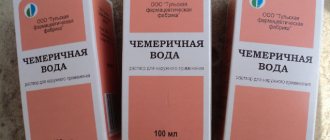Today, pediculosis is a very common parasitic disease, which is due to the specific lifestyle of most people. The risk of infection is especially high among representatives of such professions as hairdressers, makeup artists, educators, teachers, and doctors.
Today, there are a lot of shampoos against lice that promise to remove blood-sucking lice in a short time.
However, effective folk remedies, which, for example, include vinegar against lice, can also cope with this unpleasant problem. This inexpensive substance has a complex effect, destroys adult parasites, and reduces the number of nits.
So, how to treat hair with vinegar against lice and nits, which recipes are especially effective, what rules should be followed - we will consider further.
Pediculosis. Symptoms
The patient experiences severe itching, which is localized on the epidermis. The bite site begins to hurt, papules or redness appear. White lice eggs, called nits, can be found in hair.
Order an antiparasitic drug directly from the manufacturer
Characteristic symptoms can be identified:
- increased irritability and nervousness;
- insomnia and sleep disturbance;
- itching in the back of the head and behind the ears.
Note! Patients who constantly scratch bite sites are faced with crusts and additions of purulent infections.
As a result, pyoderma develops, which is accompanied by enlarged lymph nodes.
The patient becomes irritable
How can table vinegar cure head lice at home?
Before starting the procedures, I will note the main safety rule when working with vinegar. It needs to be diluted with water! One to one, at least. And when it comes to children, then take two parts water for part of the product. It is better to repeat the session if necessary than to injure the skin.
It is better not to use vinegar essence. But if nothing else is at hand, then dilute it like this: take 20 parts of water per part of the product.
What you need to prepare for the process:
- Vinegar 9 percent 100 ml.;
- Water 200 ml. (adults can take 100 ml.);
- Cotton swab;
- Cellophane cap (plastic film);
- Two towels (one for warming the head, the other for the patient’s shoulders when combing);
- A fine-toothed comb or thick comb.
Step by Step Actions
The product is diluted with water. Apply the solution to the scalp and dry strands using a cotton swab.
Please note that the liquid is applied, not rubbed in, to avoid irritation and redness of the skin. And another important point - it is necessary to moisten every hair, not to give any chance to hide for nasty living creatures.
Next, a greenhouse effect is created on the head
Put on a hat and wrap yourself in a towel. This must be done carefully so that fresh air does not penetrate under the shelter, and uninvited guests lose strength under the vapors of vinegar. Such a turban is kept for half an hour - an hour. Then the head is thoroughly washed with detergent, rinsed thoroughly, and dried with a towel. It is advisable to add droplets of aromatic oils to the shampoo - tea tree, lavender, rosemary. And now the “interesting” part begins. The victim sits comfortably at the table, his shoulders are covered with a towel or sheet. The second person (usually the mother) begins to comb out the remaining parasites on the curls with a fine-toothed comb.
How to properly comb out lice and nits on your head
- I repeat that the curls should remain damp.
- First you need to comb your hair with a regular comb in order to organize it after drying it with a towel. If you have tea tree or lavender oil in the house, put a drop on your comb. The remaining living individuals will “jump out” themselves - they are so afraid of these aromas.
- It is advisable to cover the table in front of which you are going to work with white paper. This way the result of the work will be better visible.
- It’s impossible to comb out every hair, of course. But try to grab a small number of strands in one movement.
- Carefully separate the treated areas with hairpins and elastic bands.
- Clean the comb thoroughly after each stroke. It would be great to have a container of hot water and an old toothbrush nearby. These accessories will help keep your comb clean after every combing. You can add a small amount of vinegar to the water.
- Where the frequency of the comb does not work, nits are removed by hand. Alas, we cannot do without this. After all, every living egg left behind will become a parasite after some time. I don’t think it’s worth talking about what will happen next.
- After combing, wash your hair again.
If I'm not mistaken, then almost all pharmacy packages contain recommendations to comb and rinse your hair with a vinegar solution to consolidate the effect. Isn't it true, the question arises - why pay twice?
To make sure that the table product is effective, I will explain how it works. Acetic acid does not kill lice. They are simply afraid of its smell and want to leave their habitable place. And when wrapped warmly, the heads lose strength (they become numb, like drug addicts, excuse the word), after which they are easier to wash off and comb out.
The persistence of parasites is explained by the adhesive composition that attaches the eggs to the hair. So acetic acid neutralizes this property, due to which most of the eggs are washed off. Well, those that are stuck tightly have to be combed out and selected.
Vinegar therapy must be carried out several times. Don’t delay the next procedure – do it in one or two days. Don't give insects any chance to survive.
Effect
Vinegar is a natural product. It is colorless and has a characteristic sour odor. It is used in cooking, as well as as a main or additional component in alternative medicine. The optimal concentration level is 9%.
Mechanism of action:
Order an antiparasitic drug directly from the manufacturer
- The solution is strong and can penetrate the chitinous shells of parasites. The body is damaged.
- A ready-made vinegar-based product helps facilitate the detachment of nits that are localized on the hair shafts. To completely eliminate eggs, you need to wash your hair and start combing. After the procedure, the scalp remains clean. There are cases when patients benefit from one session of the procedure.
- The liquid has a pungent odor. It is frightening for lice.
Important! Vinegar helps prevent re-infection.
This is an excellent remedy for treating children because the product is natural. Before you start, it is important to learn how to remove lice and nits, and learn the specifics of head treatment.
Vinegar is a proven remedy
Is it possible to combine vinegar with other antiparasitic agents?
Although treating hair with vinegar for lice is an effective way to treat head lice, some people prefer to use several products at the same time to be on the safe side. In most cases, the combination of different formulations is not contraindicated. You can carry out the initial treatment with one product, and after a week repeat the procedure using another drug.
Hellebore water for lice is no less effective, but more toxic than vinegar. It is better to use just one substance; you cannot combine them. Using hellebore water, you can carry out a primary treatment of the head, and for the secondary treatment (after 7-10 days) use diluted vinegar. When using hellebore water, it is important to prevent it from getting on the mucous membranes and inside. This will lead to dangerous consequences.
Which vinegar should you choose?
For treatment, vinegar can be bought at a supermarket or store. A highly concentrated product is diluted. Patients can purchase the following types of product:
- apple;
- rice.
Recently, the benefits of vinegar from cane and grapes have been proven. Malt vinegar and a product containing alcohol are highly effective. All of them are successfully used for fighting.
Order an antiparasitic drug directly from the manufacturer
The main difference from table vinegar is the use of the primary ingredient. A regular product does not contain additional ingredients or impurities.
Some recipes use grape vinegar. It contains natural acid. It thoroughly cleanses the upper layer of the epithelium. This component is often added to masks and hair rinses against lice. To get rid of parasites, you need to soak the product for 3 hours.
There are several types of vinegar
Prevention of infection
There are no methods of prevention that provide a 100% guarantee of protection . The disease has long ceased to be the scourge of dysfunctional families and does not depend in any way on personal hygiene. Lice prefer well-groomed and clean hair, so frequent hair washing will not save you from infection.
IMPORTANT: if you find lice on a child, report it to the educational institution. Otherwise, children will infect each other in a circle and treatment will be ineffective.
You can protect yourself and your children as much as possible from parasite infection by following simple rules:
- collect hair in a smooth hairstyle, especially for children at school;
- do not try on other people's hats;
- do not use other people's combs;
- do not sit, looking at one gadget “head to head”;
- Wear a rubber cap in the pool.
If a lice epidemic occurs:
- wash your hair with tar soap every 10 days;
- after each wash, rinse your hair with water and 1 tablespoon of vinegar;
- add a few drops of tea tree or eucalyptus oil to the shampoo;
- As a last resort, dye your hair with industrial dye.
Lice can live outside the human head for 48 hours . If infection occurs, it is necessary to wash all linen and clothing at high temperatures, and treat upholstered furniture with a steam generator. What cannot be washed can be taken out into the cold for several hours.
The appearance of lice is an unpleasant but common problem . It can be solved using both pharmaceutical and folk remedies, for example, using ordinary vinegar. It is important to carry out the treatment several times to complete the job and get rid of parasites forever. Following simple precautions will reduce the likelihood of re-infection.
- about the author
- VK profile
How to get rid of lice using vinegar? Rules of effective procedure
Therapy is carried out in several stages. Patients need to follow the technology:
Order an antiparasitic drug directly from the manufacturer
- Wash your hair 2-3 times and dry your hair. Next comes the step-by-step processing of the curls. It is important to ensure even distribution. Safety glasses help protect your eyes. Vinegar vapors irritate the mucous membranes.
- Next, the head is wrapped in a plastic bag. To enhance the effect, wear a rubber cap. Additionally, you can insulate your head with a towel so that the vapors begin to evaporate slowly and better penetrate the hair structure. This is the best remedy to poison parasites.
- The duration of the procedure is 30 minutes. After finishing, take a comb and begin to gradually comb out the lice. It is important to treat each area to maximize the effect. After 4 days, the procedure must be repeated. Particular attention should be paid to the back of the head, temples and the area behind the ears.
Advice! Brushing should be done outside or in the bathroom.
It is important to prevent lice eggs from getting onto your carpet or floor. To remove the strong odor, you need to wash your hair 2-3 times with regular shampoo.
Patients who have used this product leave positive reviews and often have experience using it in prescriptions. You can add raw eggs, sour cream, liquid honey.
Other auxiliary components can be added for therapeutic treatment
Side effects and precautions
When using vinegar against lice, you need to be aware of its possible side effects:
- increased dryness of the scalp;
- disruption of hair structure, appearance of split ends;
- change in hair color (they become lighter);
- dizziness (with high sensitivity to the evaporation of acetic acid).
In addition, before using this product, it is necessary to conduct a skin sensitivity test to exclude allergic reactions. Apply the prepared vinegar solution to a small area of skin on the inside of the elbow for 30 minutes. If there is no reaction, you can begin the procedure for removing parasites.
Important! If during treatment you experience a burning sensation, itching, or pain, you must immediately rinse the composition from your hair, then wash your hair with shampoo. This method will still have to be abandoned.
As a precaution, vinegar should not be used to treat head lice in children under 6 years of age, as well as in people with:
- skin diseases and skin damage (eczema, neurodermatitis, abrasions, scratches, etc.);
- exacerbation of chronic diseases of the upper respiratory tract (bronchial asthma, bronchitis, lung failure, etc.);
- acute intolerance to strong odors.
Vinegar for lice and nits: recipe, proportions
Before starting, study all the recommendations and rules to avoid mistakes. This product is often used as an independent or auxiliary component. For adults, a concentration of 9% is taken, and for children this figure is reduced to 5%.
Order an antiparasitic drug directly from the manufacturer
Water can be used to dilute. It needs to be filtered or boiled. Stir the liquids in equal proportions. Application of the product is carried out using technology. Exposure duration is 30-40 minutes.
A concentration level of 70% often leaves burns on the skin. They are difficult to heal and can leave scars. The essence in high concentration is diluted in the following proportion: 1:16 with clean water. After dilution, the procedure can be carried out using generally accepted technology.
There are several proven and effective recipes when vinegar is added and mixed with other substances:
Order an antiparasitic drug directly from the manufacturer
- Oil based mask. Take vinegar in a concentration of 9%, mix with oil in equal proportions. The finished mixture is applied to the hair and distributed over the entire length. The head is covered with a plastic bag or wrapped in a rubber cap. The exposure time is 7 hours. Experts recommend doing this before going to bed. In the morning, you need to thoroughly wash your hair with shampoo to remove the smell and composition of the mask. Nits and dead parasites are washed away with the water. You can additionally add aromatic oils to rinse the water.
- Apple cider vinegar with oils. This is a proven and effective recipe that is often used in pediatric practice. Apple cider vinegar has a mild odor and has beneficial properties. For treatment, use 130 ml of the product, dilute it in a glass of warm water. Additionally, add a couple of drops of eucalyptus, tea and geranium oil. All ingredients are thoroughly mixed and combined. After application to the hair, the head is carefully wrapped and insulated with a towel to create a greenhouse effect. Duration: 6-8 hours. When the procedure is completed, you need to thoroughly comb out lice from your hair and wash it with regular shampoo.
- Mask based on vinegar and eggs. To prepare an effective remedy, use 1 spoon of dry mustard, 100 ml of vinegar. You can choose any one from the list provided. Additionally add 1 raw egg. The ingredients are thoroughly mixed to obtain a homogeneous mixture, which is applied to the hair and carefully distributed over the entire length. You need to keep the composition for 3 hours.
Important! After each procedure, the hair is thoroughly combed and washed with regular shampoo.
To eliminate lice, it is necessary to create a greenhouse effect and carefully wrap your head.
Contraindications and dangers
It is best to use vinegar to remove lice from children in a well-ventilated area, since vinegar vapors at a certain concentration can have a negative effect on the mucous membranes of both adults and children. In addition, when using various additional components, you should pay attention to the fact that they can cause allergies if a person is intolerant to the component or its components. This is especially true for aroma oils, the concentration of which is quite high.
Regardless of age, before starting treatment with vinegar, it is necessary to examine the head for scratches, wounds and other damage. Even a slight damage to the skin if vinegar gets into it will cause severe pain, followed by burns and damage to the epithelium.
The strong smell of vinegar is a reminder that people suffering from diseases associated with pulmonary insufficiency should be careful when working with this acid. The acrid vinegar aroma can cause shortness of breath followed by loss of consciousness.
Women during pregnancy and lactation should also approach this type of treatment with caution. Despite the fact that vinegar does not penetrate into the blood, its effect on the fetus and on a breastfed child has not been studied at all.
In any case, if severe pain, itching and other unpleasant symptoms occur, the vinegar should be washed off with plenty of warm water, and then a nourishing mask or lotion used every day should be applied to the hair and scalp.
A course of treatment
To completely get rid of eggs, 4-5 procedures are carried out. The quantity is determined individually. Nits can become entangled in hair. After a few days, new lice hatch from them and begin to reproduce again.
Insects will gradually be eliminated from the hair. With regular use, egg deposition is prevented. The patient or the child’s parents need to carefully examine the head in order to notice nits in a timely manner. Even with a small number of them, the procedure is repeated and continued until the parasites are completely destroyed.
Order an antiparasitic drug directly from the manufacturer
Folk remedies are not a panacea for all diseases
Can we get rid of a contagious and very unpleasant disease with the help of such a banal and accessible remedy?
So why overpay then? We throw out the first aid kit and switch to folk remedies! Right?
But no, you shouldn’t think that this product is better than modern specialized insecticidal preparations. Unfortunately, the effectiveness of apple cider vinegar has been greatly exaggerated.
It can indeed help a little with head lice, but it will not completely destroy the parasites. I will say more: for this tool to help, it must be used correctly, and you will learn how this is done only after reading this article to the end.
Contraindications to the use of vinegar
Before starting therapy, it is important to familiarize yourself with contraindications so as not to aggravate the situation. You can contact a therapist or pediatrician. There are several main contraindications:
- attacks of suffocation;
- allergies to strong and pungent odors;
- history of allergic reaction;
- poor lung function.
In the absence of contraindications, you should note that other patients should not use vinegar if they experience severe dizziness from the smell. If this condition occurs, you need to go out into fresh air.
Vinegar should not be used if you have scalp allergies.
Is it possible to use vinegar in the treatment of head lice in children?
Do not forget that table vinegar is diluted acetic acid, and any acid can cause an allergic reaction in the body, so you need to find out in advance, especially when it comes to treating head lice in a child. This can be done by applying a little mixture to the crook of your elbow. If the skin turns red, burning and itching appear, then it is better not to use vinegar.
Sometimes children do not tolerate a strong specific smell, so it is necessary to secure a plastic bag on their head as tightly as possible so that the smell does not leak out from under it (this can be done with a scarf, and then wrap a terry towel over it or put a warm hat on the child).
Many doctors recommend cutting a child's head in case of head lice, but this option is only suitable for very young children. To make it easier to fight lice, boys can get a fashionable short haircut, but girls who do not want to sacrifice their “braid - girlish beauty” will have to be patient.
Alternative Recipes
There are also alternative recipes. Kerosene has been used for a long time. It only kills adult lice. With regular use, suffocation and severe poisoning occur. When kerosene is absorbed into the body of insects, damage to the central nervous system occurs and subsequent death. This product does not have a strong effect on nits, so to obtain the effect, the procedure is carried out at least 3-4 times.
Order an antiparasitic drug directly from the manufacturer
Important to remember! This substance has a huge number of contraindications.
Patients may experience burns if they come into contact with the chemical. Hair can quickly fall out. Kerosene should not be used by children.
Dr. Komarovsky talks about the features of therapy in children:
Vinegar for lice and nits is often used at home. Its effect has been tested for years, so patients leave recommendatory and positive reviews. It is recommended to begin removing lice with vinegar by consulting a doctor. He will study all the indications and contraindications and provide advice. Often lice require additional diagnostics.
Specialists study the epidemiological history and examine the scalp using a Wood's lamp. It helps to get a good look at living nits, assess bite sites, and characteristic rashes. It is important to remember that lice need to be killed gradually because they often hatch over several times.
Proven recipes and treatments:
Why are lice dangerous and does vinegar help?
Lice are small insects that crawl along the scalp. In the first days of infection with parasites, it is very difficult to see them. But a person feels discomfort, which determines the onset of lice. You can find out more about the symptoms of the disease on our website.
- The first sign of lice is itching of the scalp in the area of the back of the head and crown.
- The detection of grayish-bluish spots on the skin indicates the body’s reaction to an enzyme secreted by insects.
- When scratching, microcracks and wounds remain on the skin, through which infections can enter and develop complications of the disease.
- If you look closely, nits are attached to the hair at a distance of 1–1.5 cm - insect testicles, from which lice later emerge. We suggest you find out how to distinguish dandruff from nits on our website.
Pediculosis is dangerous because if it is not treated, it can cause serious complications. Lice are carriers of relapsing fever and vector-borne diseases. It is especially alarming when parasites appear in children. Indeed, due to an unformed immune system, their body is not able to independently resist viruses and microbes. The main food of lice is human blood.
Attention! Untimely treatment of head lice can weaken the child’s body so much that in severe cases, death can occur.
There are various products on sale that get rid of lice and nits, but in many they cause an allergic reaction. In such situations, people resort to folk remedies. Vinegar has been used for head lice for a long time, but using it incorrectly can cause side effects and even accidents. Therefore, you must be extremely careful before using it. There are several types of vinegar, which of them helps better in terms of killing lice and nits, we will consider in more detail.
Types of vinegar:
- apple;
- dining room;
- vinegar essence;
- wine.
After using any type of vinegar for pediculosis, effective destruction of parasites is observed. Acetic essence must not be applied in its pure form, otherwise you may get a scalp burn . And if you inhale the smell of the solution, your respiratory organs will be damaged.
For processing, it is better to purchase apple cider vinegar or table vinegar. Apple cider vinegar can be used without dilution, its concentration is only 3%, and table vinegar must be diluted 1:2 and only then applied to the hair. The wine vinegar solution does not cause any burns; it can be applied at night and washed off in the morning.
The main thing is that when using vinegar in the fight against lice and nits, you must follow the instructions and strictly follow the recipe.
We recommend reading: recommendations and procedures for treating head lice with hellebore water.
Chemical composition and beneficial properties of vinegar
There are the following types of vinegar:
- Rice.
- Alcoholic.
- Fruity.
- Fruit.
- Balsamic.
- Malt.
- Synthetic.
The chemical composition of the product depends on the raw materials from which it was made. The most popular in cooking and medicine are table and apple cider vinegar.
The composition of table vinegar includes the following substances:
- Water (about 94%).
- Carbohydrates.
- Pectins.
- Food acids.
- Minerals: Ca, Mg, P, Fe, Na, Zn, Mn, Se.
The calorie content of table vinegar is small and amounts to only 18 kcal per 100 grams.
Apple cider vinegar contains the following substances:
- Water (92-93%).
- Pectins.
- Food acids: tartaric, citric, malic, acetic.
- Vitamins: groups B, A, C.
- Minerals: Mg, K, Ca, P, Na.
The calorie content, like that of table food, is 18 kcal per 100 grams.
The pectins included in the product help lower cholesterol levels, prevent the formation of cholesterol plaques and serve as a preventive measure for heart and vascular diseases.
Food acids have an antiseptic, bactericidal, fungicidal effect, destroy pathogenic bacteria, viruses and strains.
B vitamins improve skin condition, normalize fat metabolism, accelerate the healing of damaged tissue, increase brain activity, and improve the functioning of the nervous system.
Vitamin C strengthens bone and dental tissue, increases the strength and elasticity of blood vessels, and accelerates recovery after illnesses.
Vitamin A slows down cell aging, improves the functioning of the immune system, and increases visual acuity.
Magnesium is necessary for the normal functioning of the nervous and muscular systems and prevents the development of urolithiasis.
Manganese reduces glucose levels, improves cerebral circulation, and prevents the formation of cholesterol plaques.
Potassium normalizes heart rate and maintains water-salt balance in the human body.
Vinegar has the following beneficial properties:
- Suppresses the growth and development of pathogenic microorganisms, viruses, strains.
- Destroys pathogenic fungi.
- Relieves inflammation.
- Eliminates nausea.
- Lowers body temperature.
- Removes toxins and impurities.
- Reduces muscle pain.
- Helps cope with hiccups.
- Increases immunity.
- Reduces appetite.
- Prevents the formation of cholesterol plaques.
- Improves blood circulation.
- Strengthens the cardiovascular system.
- Helps get rid of skin rashes.
- Reduces blood pressure.
